

Male Sexlessness is Rising But Not for the Reasons Incels Claim
A recent terrorist attack in Toronto, which left 10 people dead, has brought global attention to the “incel” movement, which stands for “involuntarily celibate.” The term refers to a growing number of people, particularly young men, who feel shut out of any possibility for romance, and have formed a community based around mourning their celibacy, supporting each other, and, in some cases, stoking a culture of impotent bitterness and rage at the wider world. In a few cases, this rage has spilled over in the form of terrorist attacks by “incels.” While the incels’ misogyny deserves to be called out and condemned, their ideas are unlikely to just go away. As such, the question must be posed: is the incel account of modern sexual life correct or not?
Incel communities tend to believe a few key facts about modern mating practices. First, they tend to believe women have become very sexually promiscuous over time, and indeed that virtually all women are highly promiscuous. The nickname incels use for an attractive, sexually available woman is “Stacy.” Second, they believe a small number of males dominate the market for romance, and that their dominance is growing. They call these alpha-males “Chads.” Finally, they tend to argue that the market for sex is winner-take-all, with a few “Chads” conquering all the “Stacies.” The allegedly handsome and masculine Chads are helped along by social media, Tinder, and an allegedly vacuous and appearance-focused dating scene, such that modern society gives Chads excessive amounts of sex while leaving a growing number of males with no sexual partner at all. These left out men are the incels.
This view is basically wrong. But it turns out to be wrong in an interesting and informative way.
How Much Sex Are People Having?
First of all, we may wonder about the actual trends in sexual behavior. Using data from the General Social Survey (GSS), it’s possible to estimate about how often people of different groups have sex. For this article, I will focus on individuals aged 22-35 who have never been married, and particularly males within that group.
Most groups of people age 22-35 have broadly similar amounts of sex; probably something like 60-100 sexual encounters per year. Never-married people have the least sex, about 60-80 encounters per year, while ever-married people have more sex, about 70-110 encounters per year, on average. Historically, never-married men have reported higher sexual frequency than never-married women. However, in the 2014 and 2016 GSS samples, that changed: never-married men now report slightly lower sexual frequency than never-married women. This is mostly because men are reporting less sex, not that women are reporting more sex. Female sexual frequency is essentially unchanged since 2000. In other words, a key piece of the incel story about rising female promiscuity just isn’t there.
But sexual frequency may be dominated by “Chads” and “Stacies.” What we really want to know is what share of these men and women have not had any sex. The graph below shows what share of these young men and women had not had sex at all in the last 12 months, by their sex and marital status.
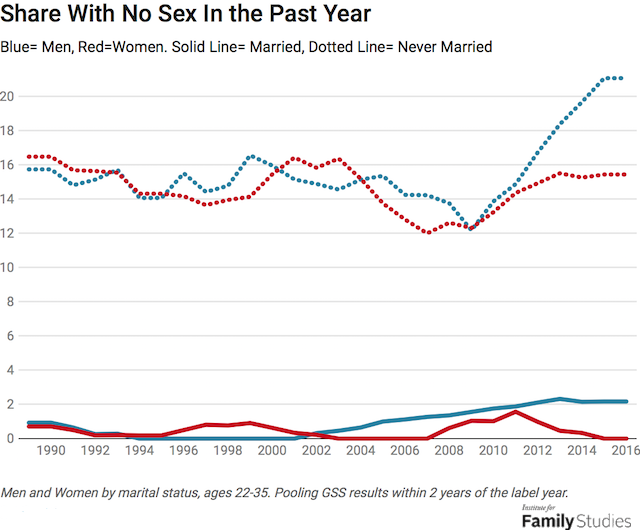
The share of people of each status who report not having had sex in the past year shows interesting trends that seem to support the basic incel account of changes in mating markets. Recent years have seen increasing sexlessness for never-married men. Celibacy is approximately stable among women. Notably, male sexlessness is also rising among married men.
On the one hand, the incel story of rising male celibacy seems confirmed here; more and more never-married young men are experiencing long sexual droughts. But on the other hand, incels are basically wrong in suggesting that virtually all women are promiscuous: female sexlessness has been roughly stable over time and indeed has actually risen since the period from 2005-2010.
However, two other large surveys, the National Survey of Family Growth (NSFfG), and the National Health and Nutrition Examination Survey (NHANES), also ask about sexual behavior. Their results do not confirm the trends seen in the GSS. However, they also have slightly different questions and slightly different survey populations, so they may not be directly comparable. The NSFG, for example, shows a far higher rate of sexlessness to begin with.
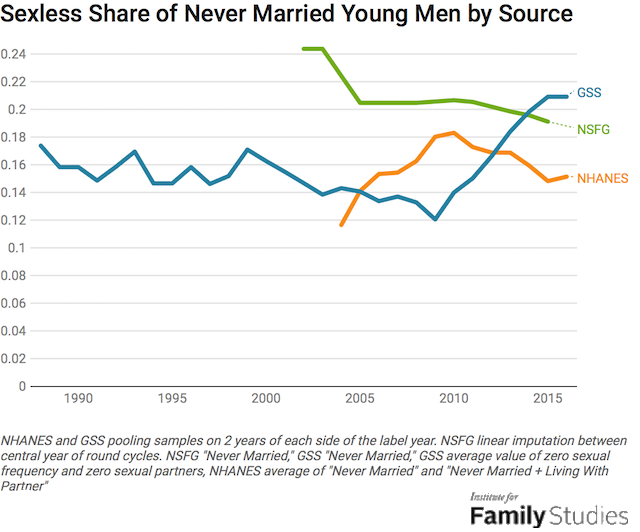
The graph above shows that while there’s some reason to think a growing share of never-married young men is going sexless based on GSS data, it could be that the sexless share among these young men is about stable, as the NHANES shows, or even falling, as the NSFG shows.
The incel account of events thus far is maybe true in the GSS, but faced strong rebuttals from the NHANES and NSFG data. Not a glowing endorsement of the incel narrative!
Do a Few Sexual Alphas Dominate the Sexual Economy?
But even assuming the GSS data is correct, we can ask if another piece of the incel narrative is true. Do a few Chads and Stacies really monopolize the market for sex? Many incels quote a rule of thumb that 20% of men have 80% of the sex. Is this true?
It turns out, the answer is no. And of course, it isn’t! Imagine how much sex those 20% of men would have to be having! A substantial share would need to be doing two-a-days on a regular basis to maintain that kind of share. In reality, according to the GSS, the top 20% of the most sexually active never-married young men have about 50-60% of the sex. It’s about the same for women, and these shares are basically stable over time. Measuring the number of partners instead of sexual frequency, the top 20% most promiscuous men account for about 60% of male sexual partnerings, and the trend is, again, quite stable over time.
Thus, whatever the change in total sexlessness, there’s no appreciable change in the concentration of sex among never-married young men and women. The core incel story about what’s going on here—that a few Chads are hoarding a growing share of Stacies, depriving incels of mates—just doesn’t hold up. The top 20% of unmarried men are having about the same share of total sexual activity or sexual partnerings as has been the case for decades.
And of those very promiscuous men, a small share actually report having paid for or being paid for sex. That is, a few of these men whom incels might think are Chads based on the data actually have their high sexual frequency not due to being so desirable, but due to hiring prostitutes, or themselves being male sex workers.
So if it’s not rakish Chads hoarding all the women, what’s going on?
The Decline of Youthful Marriage
We can take the data from the three sources on sexual behavior (GSS, NHANES, and NSFG), and apply it to available data from the American Community Survey and the Decennial Census about marriage, and see what share of the total male population is probably sexless. The graph below shows estimates the share of male population aged 22-35 who have never been married and who have not had sex in the last year.
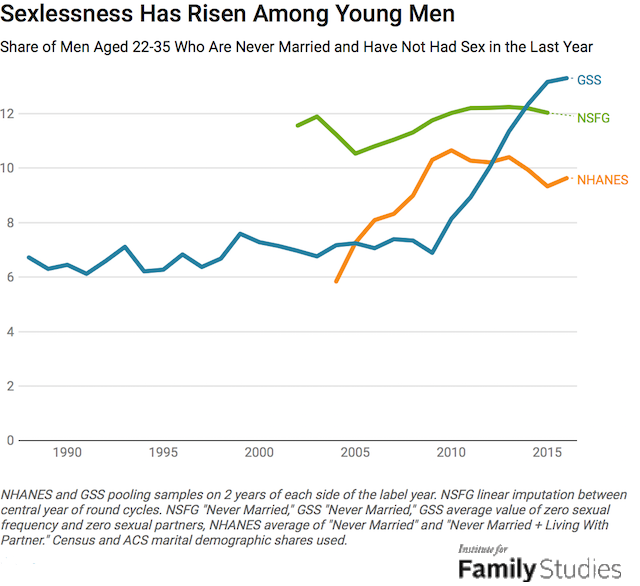
The trend in the total male population aged 22-35 made up of these sexless men is changing. All sources, including the NSFG and NHANES, show the latest values to be higher than values estimated around 2000-2005. In other words, the share of the male population aged 22-35 who have never been married and haven’t had sex in at least a year is almost certainly higher than it was a decade or two ago. The exact trend, as well as whether this figure is still rising or not, is much more debatable, but the very broad outcome of higher sexlessness today than a decade ago is indisputable.
The main factor driving this trend, however, isn’t Chads and Stacies, but just declining marriage rates among young men. The share of men aged 22-35 who have never been married is higher today than at any time since the first data we have, going back to 1880. The married share for these men is far lower than the historic norm. Unmarried people have less sex in general, so even if celibacy rates within marital status are the same, the sexless population grows.
Why Are Sexless Men Sexless, Aside From Delayed Marriage?
But how much of this is really about involuntary celibacy? Interestingly, the NSFG (which has about 1,000 never-married men ages 22-35 in each sample period)also asks men who have never had sex (about half to two-thirds of the men who haven’t had sex in the last year) why they are still virgins.
The lion’s share of the decline in virginity in the NSFG is due to falling religiosity. The share of never-married men ages 22-35 who were virgins due to religious abstention fell from 4.7% in 2006-2010, to 3% in 2013-2015. The share who are virgins due to fear of STDs has fallen from 0.8% to 0.4%, while the share abstaining due to fear of conception has risen from 0.1% to 0.5%. The share who are in a relationship but just haven’t had the right moment has fallen from 0.8% to 0.4%. Meanwhile, the share who are virgins due to not having found a suitable partner yet has risen from 3.6% to 4%, while the share who cite “other” reasons has risen from 1.6% to 2.5%.
Thus, while the NSFG shows sexlessness declining, essentially involuntary sources of sexlessness, which I consider to be “other” and “lack of a suitable partner,” are stable or rising. Virtually, the whole decline in NSFG-measured sexlessness is a decline in voluntary sexlessness, that is, sexlessness due to religious, timing, or health concerns. Using NSFG figures for sexual abstention and ACS marital demographics, we can estimate a “hard-core incel population,” that is, the share of never-married men ages 22-35 who have never had sex, and whose reason for never having had sex isn’t abstention for religious, timing, or health reasons.
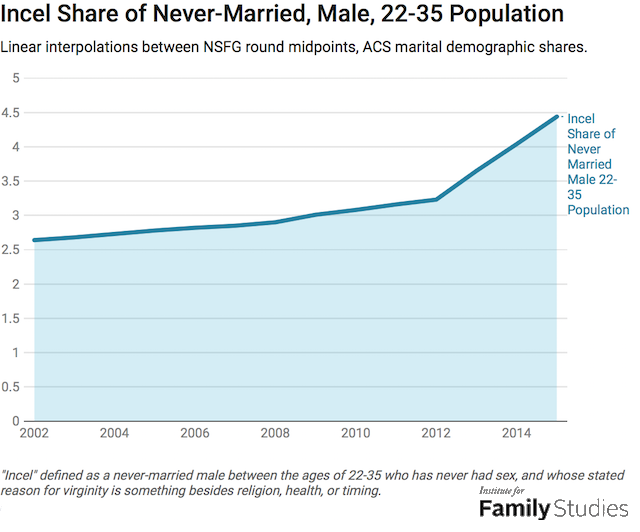
This hard-core incel group is indeed growing as a share of the male population. The NSFG’s sample size, over 1,000 never-married men between the ages of 22 and 35 with sufficient questionnaire completion to estimate sexual behavior and reasons for virginity if they have not had sex, is large enough to be decently confident of these results.
But the 68% increase from 2002 to 2015 in the incel share of the male, never-married, 22-35-year-old population is mostly due to a decline in marriage, not never-married men having less sex. Rising involuntary virginity among never-marrieds accounts for around 27 percentage points of the increase, with the other 41 percentage points coming from a declining married share of the population. It may also be that some of these “incels” are males who were formerly, or would formerly have been, religious, and while they no longer abstain for religious reasons, nonetheless they may continue to hold some degree of religious norms regarding “high standards” for a first sexual encounter.
In other words, incels are right to see themselves as part of a novel and fairly extreme change in our society’s sexual behavior, with a growing share of sexless young men. But the big change isn’t a growing share of alpha males hoarding all the sex, nor women suddenly becoming far more choosey amid rising promiscuity; rather, it’s just that marriage is being delayed, which means that rates of marriage-status-controlled celibacy that aren’t historically extremely unusual result in very unusual rates of total population-wide sexlessness.
We can also see what factors tend to predict virginity among never-married young men in recent years. For example, virginity is somewhat more common among more educated young men; this is true for both the men I classify as involuntarily celibate and especially those who are voluntarily celibate.
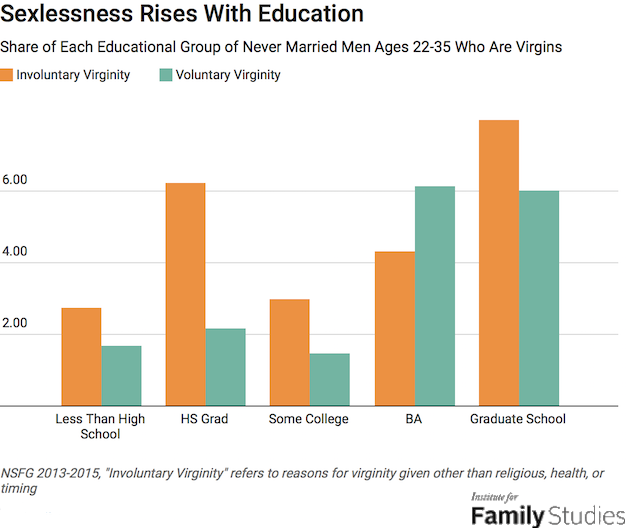
The NSFG also shows that virginity, both voluntary and involuntary, is higher among men living with their parents, as shown in the figure below.
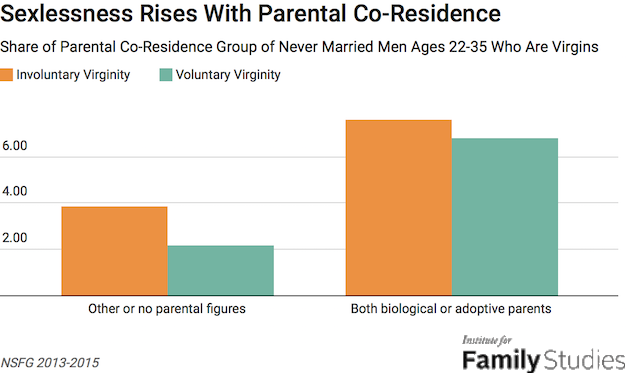
About 8% of never-married young men living with their parents are involuntarily sexless, and another 7% are voluntarily so. Among men not living with their parents, it’s just 4% involuntarily sexless, and 2% voluntarily so. Looking at sex in the last year instead of virginity, never married young men without their parents are about 17% sexless, versus nearly 30% among those who live with parents. Even when these variables are combined together, more education is associated with more sexlessness among both men who live with their parents and men who do not, and living with parents is associated with more sexlessness across all educational levels.
Some of that is due to voluntary celibacy. Men who live with their parents are more likely to be religious or be concerned about STDs, or the risk of conception. When we restrict to just involuntary celibacy, the sample size becomes too small to say anything conclusively about whether more education or parental co-residence is the dominant driver of virginity. It still seems like living with parents increases virginity, especially for less-educated men, but the effect size is not statistically significant.
Overall, male virginity in the NSFG is associated with higher education and residence with parents. On the other hand, data from the GSS suggests that not having had sex in the last year may be associated with less education, although this isn’t a measure of virginity.
But whatever the direct effect of education on never-married men, the primary cause of the rise in sexlessness is simply the increasing delay of marriage. The delay in marriage has numerous causes, of course, but probably the most powerful driver of marital timing also relates to education. Men and women are much less likely to get married while attending school, and across times and countries, an increase in the years of schooling is associated with later age of marriage, though more-educated people do tend to get married eventually. Thus, as more and more schooling becomes necessary for a good middle-class job, marriage gets pushed later and later, leaving more young people (men and women!) companionless and lonely.
The rise of young male sexlessness isn’t about Chads and Stacies; it isn’t primarily about Tinder or Bumble; it’s not mostly about attitudinal shifts in what women want from relationships; and it’s not mainly about some new war between the sexes. It’s mostly about people spending more years in school and spending more years living at home. But that’s not actually a story about some change in sexual politics; instead, it’s a story about the modern knowledge economy, and to some extent exorbitant housing costs. As such, it’s no surprise that rising sexlessness is being observed in many countries. This, in turn, suggests that finding a solution to help young people pair up may not be as easy.

-
-
-